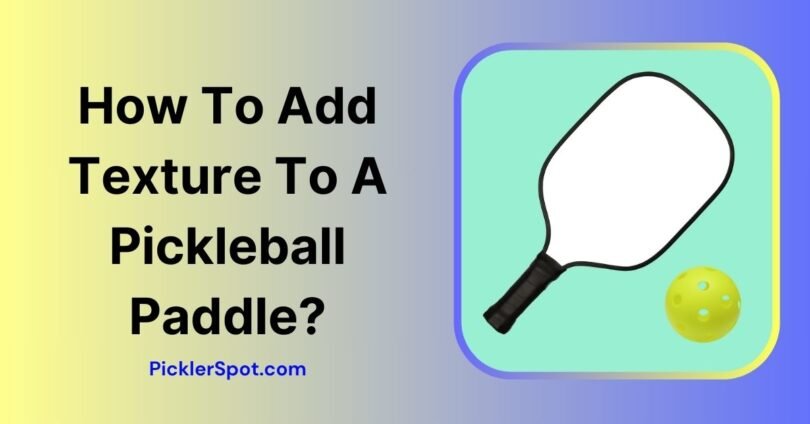Have you ever been caught in a fiery rally only to get your Paddle to give up its grit for maximum potential of spin due to wear and tear while the ball keeps on slipping on it like a snail on a slippery slope?
If not, then God forbid just the sound of it happening in the midst of a session feels embarrassing and downright cringe because it would put even the most professional player in a backfoot position.
Now if you could afford to swap out for a newer Paddle, you could easily have a workaround, however, I wouldn’t call it ideal, especially if you are on a budget.
Speaking of which, for my Pickleball buddies on a budget I have Curated an article on “How to add texture to pickleball paddle?” Feel free to steal my tips and save yourself some money.
Identifying The Grit Levels Of Your Pickleball Paddle
In order to confirm that your Pickleball Paddle has indeed lost its touch, make sure you check for these signs.
1. Glossy Patches
The first and foremost sign of your Paddle giving up its optimal abrasiveness is checking out small glossy patches under bright light or under direct sunlight. This usually happens once the UV or Oleophobic coating wears off due to regular wear and tear or frequent point of contact.
It might also be the result of scorching heat or improper storage, which may result in the outer layer of the paddle being peeled off.
2. Spin Loss
After years of use, you may notice the frequency of spin and drastic trajectory change when hitting the ball at certain parts of your Paddle.
This might be due to minor cracks being formed causing the Paddle to lose top or back spin. You would also feel some form of inconsistency even if you aren’t really spinning your ball at all.
In some instances, the cracks might amplify the trajectory causing the ball to either fall in short or have lesser momentum which might put you in a rough spot if you are executing close-range Dinks.
3. Weird Sound Output
Another huge Paddle texture Degradation can be judged through the sound it produces once a ball hits the sweet spot or the edges of the Paddle. Try bouncing the ball for a couple of seconds and check where it produces the least amount of echo.
You can even record yourself while doing so and evaluate whether or not your Paddle has lost its outer layer integrity where it has a texture applied to it.
4. Fades Or Ball Marks
Fades or Ball marks only appear once your Paddle has gone through an extensive form of degradation after passing through hours of rigorous sessions.
These marks become eventually apparent if you use your Paddle in aggressive volleys or don’t really handle it properly resulting in chip damage appearing on the face of the Paddle.
Once you have identified scratches or marks appearing, your Paddle might be in dire need of texture makeup which is a complicated process, as, explained comprehensively below.
How To Add Texture To Pickleball Paddle?
Once you have identified the root cause of your Pickleball Paddle being weary and out of touch due to lack of grit, it is time to add a customized layer of texture to make it as good as new.
1. Cleaning The Paddle
First of all, you will need to remove any excessive dust or debris particle that has been clogged up on your Paddle’s Face. every paddle has a protective coating mixed with adhesive which due to corrosion causes a jagged effect to appear on it. Try rubbing it off to make the Paddle appear squeaky clean.
2. Sanding the Paddle
Now, use sandpaper and evenly rub it across the face of the paddle to increase the texture, you can either use circular or uniform motion to produce a pattern.
However, make sure you don’t overdo it otherwise you will ruin the outer layer more than it is needed.
The goal is to create enough friction so that the Pickleball can attain spin without losing or compromising its momentum, so try to be even and gentle with your sandpiper and choose the one with the lowest grit to minimize the chances of pattern-based errors.
3. Applying Texture Spray
Wipe the dust build-up apply a thick coating of Texture spray or silicon coating, and let it cure for a couple of minutes so that the textures created attain a prominent effect on your Paddle.
Additionally, you can also add plastic dip sprays which act as a rubberized latex-based coating that mimics an outer protective layer that will make your Paddle transform into its mint condition.
You can even use UV coating afterward, in case you want to further reinforce your paddle from direct sunlight since your Paddle would be exposed to harsh conditions after sanding the outer layer.
What Are The Advantages Of Adding Texture To Pickleball Paddle?
Here are a couple of benefits you may attain once you have enhanced the texture of your Paddle.
- It’s an innovative yet cost-effective approach to transform your Paddle to mint condition and make it as good as new, at least for a year or so. If you are on a budget or simply do not want to spend much on equipment, adding extra grit might do the trick for you, saving you plenty of time and money.
- You might even attain more grip and control over the ball than usual and even get an edge over your opponent. Although the friction produced might not be as good as buying a new Pickleball Paddle, in comparison to a Paddle with a worn-out texture, it would still produce exceptional results.
- Lastly, if you want to get the most out of your Paddle, adding extra grit and texture cause prolong its lifespan, especially if you apply customized protective coating afterward.
In Conclusion
So there you have it folks, after going through this comprehensive guide on “How to add texture to pickleball paddle?” I am fairly confident that your weary and worn-out Paddle will be as good as new after following all the steps mentioned above.
Just make sure you aren’t too hard on the sanding part, otherwise, you may exacerbate the overall texture or even cause it to become uneven.
Subsequently, don’t forget to add protective silicon glue afterward to preserve the texture to prolong its life span. That being said, feel free to bookmark this article, so you can easily access it in the future as I will be updating it so that you can stay up to the trend.









